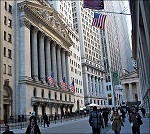Courtesy of Pam Martens
We’re going to do today what mainstream media has failed to do for the American people so far this year — as well as prior to the onset of the 2008 financial collapse on Wall Street. We’re going to connect the dots that strongly suggest that both the U.S. and global financial system have a real problem occurring right under the fogged lenses of Congress.
Dot 1 — Freezing Customers Out of their Mutual Fund. Let’s start with our reporting on July 11 of this year, titled Is There a Stealth Financial Crisis? Alarm Bells Are Ringing. In that article we pointed out that one of Britain’s high profile money managers, Neil Woodford, had frozen customer withdrawals from his flagship $4.7 billion Woodford Equity Income Fund. The latest news is that the fund is not expected to reopen until at least December and we wouldn’t hold your breath on that. One of the key problems was the fund’s hefty positions in illiquid stocks that were hard to value. We further pointed out that in the same balmy months of the summer of 2007, when the serious Wall Street crisis was being largely ignored by mainstream media, the U.S. investment bank, Bear Stearns, shuttered two of its hedge funds which had held about $1.5 billion of investor funds, announcing that they were mostly worthless. That was followed the next month by France’s largest publicly traded bank, BNP Paribas, announcing that it was freezing withdrawals from three of its funds, citing “evaporation of liquidity” and the inability “to value certain assets.”
Dot 2 – Hard to Value Assets on Bank Balance Sheets. Illiquid or hard to value investments on the books of the banks in the U.S. are called “Level 3” assets. The Office of the Comptroller of the Currency (OCC) doesn’t think that’s a problem at U.S. banks. In its most recent quarterly report for the period ending June 30, 2019, the OCC states that Level 3 trading assets at U.S. banks “peaked at $204.1 billion at the end of 2008” and are now a very tame $27 billion.
The OCC allows your contentment with those numbers to last for a full 5 seconds before adding this: “Because banks cannot observe inputs into the models that determine the fair value of these illiquid exposures, banks use their own assumptions in determining their fair values.”
If you know anything about JPMorgan mismarking its $6.2 billion in losses on derivatives in the London Whale scandal in 2012 or Citigroup misstating by tens of billions of dollars its subprime losses hiding out in off-balance-sheet Structured Investment Vehicles (SIVS) in the Cayman Islands in 2008, then you might take the OCC’s assessment of Level 3 containment with a grain of salt.
…




